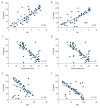Decreased Synovial Fluid Biomarkers Levels Are Associated with Rehabilitation of Function and Pain in Rotator Cuff Tear Patients Following Electroacupuncture Therapy
- PMID: 32915775
- PMCID: PMC7507797
- DOI: 10.12659/MSM.923240
Decreased Synovial Fluid Biomarkers Levels Are Associated with Rehabilitation of Function and Pain in Rotator Cuff Tear Patients Following Electroacupuncture Therapy
Abstract
BACKGROUND The aim of this study was to assess inflammatory cytokines levels in synovial fluid (SF) before and after electroacupuncture (EA) treatment and to explore whether these biomarkers are associated with function of rotator cuff tear (RCT) patients. MATERIAL AND METHODS We recruited 54 patients with RCT and separated them into an EA group and a control group. The SF biomarker levels were detected at baseline and at 6-week and 6-month follow-up. The symptomatic severity was evaluated by visual analog scale (VAS), Constant-Murley score, and American Shoulder and Elbow Surgeons score (ASES). We also investigated the correlation between symptomatic severity and biomarker levels in SF of the shoulder joint. RESULTS The reductions in VAS and improved functional score (ASES and Constant-Murley score) were significantly different between the 2 groups, and SF biomarker concentrations were significantly lower in the EA group. IL-1ß levels were significantly negatively correlated with Constant-Murley score (r=-0.73, P=0.04) and ASES score (r=-0.59, P<0.001) and positively correlated with VAS scores (r=0.81, P=0.004). IL-6 levels were significantly negatively correlated with Constant-Murley score (r=-0.67, P=0.03) and positively correlated with VAS score (r=0.7, P=0.01). MMP-1 levels were significantly negatively correlated with ASES score (r=-0.57, P<0.001). CONCLUSIONS The biomarkers in SF were directly associated with shoulder pain and shoulder function in rotator cuff tear. EA, as a safe and effective conservative therapy, obviously decreased the level of inflammatory cytokines in RCT patients, accompanied by a reduction in shoulder pain and improved function.
Conflict of interest statement
None.
Figures
References
-
- Deprés-Tremblay G, Chevrier A, Snow M, et al. Rotator cuff repair: A review of surgical techniques, animal models, and new technologies under development. J Shoulder Elbow Surg. 2016;25(12):2078–85. - PubMed
-
- McElvany MD, McGoldrick E, Gee AO, et al. Rotator cuff repair: Published evidence on factors associated with repair integrity and clinical outcome. Am J Sports Med. 2015;43(2):491–500. - PubMed
-
- Lewis J. Rotator cuff related shoulder pain: Assessment, management and uncertainties. Man Ther. 2016;23:57–68. - PubMed
Publication types
MeSH terms
Substances
LinkOut - more resources
Full Text Sources
Medical



